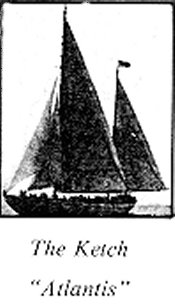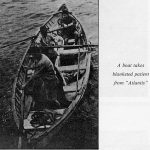With the advent of aircraft into the Coast Guard, the ramifications of one crashing had to be pondered. The good done with aircraft far outweighed the possible cost in aircraft and people.
The first tragedy to strike CGAS Brooklyn happened while it was still in its infancy. At 8 A. M. on 15 July 1939, a radio message was received at Marine Hospital on Staten Island from the ketch “Atlantis”. “Atlantis”, a research vessel used by the Oceanographic Institute at Woods Hole, Mass., had been out to sea for several months measuring area and currents of the Gulf Stream. The message received by the hospital was that one of the ” Atlantis ” crewmen was seriously ill with pneumonia. The hospital then radioed back to ” Atlantis ” to ” force liquids… administer aspirin… and put man ashore as soon as possible.” “Atiantis” was located 15 miles southeast of New York. At top speed it would take 18 hours to reach port. The Coast Guard was then requested to medivac the ill crewman. With the decision made to medivac the ill crewman, a Hall-Aluminum PH-2 flying boat, serial number V-164, was readied for the mission. This aircraft was one of the three original PH-2 type aircraft to be assigned to CGAS Brooklyn. At 1005 A.M. V-164 took off from Floyd Bennett Field with a crew of seven.
Shortly before noon, the aircraft reported that it had sighted the ketch and was preparing to land. The on scene weather was dangerous with ” thunder squalls and cross swell” as reported by the aircraft. The aircraft, however, landed safely and awaited the ill crewman who had to be rowed over to the aircraft in a lifeboat. With the ill crewman aboard the aircraft and the lifeboat clear, the aircraft taxied over the swells into the wind. On takeoff the aircraft rose slightly, leveled off and mysteriously, with the throttles set at takeoff power, dove nose first into the waves. The lifeboat from “Atlantis” quickly rowed back over to the stricken aircraft and rescued five of the Coast Guard crewmen. Trapped in the forward compartment of the aircraft were the pilot, co-pilot and the crewman from “Atlantis”. The pilot, Lt. W.L. Clemmer, co-pilot AMM2(AP) J. Radan and the “Atlantis” crewman all drowned.


Two days later an official board of inquiry was convened to find a cause for the accident. From many conflicting and vague details, the board deduced that V-164 struck a long swell at the moment of liftoff, lost speed and nosed over into the waves with throttles full open.. The following photos were taken from the ketch “Atlantis” on that fateful day.
It would be nearly twenty years later that another tragedy would strike the air station. On 22 August 1957, a Grumman Albatross UF-2G serial number 1259 with a crew of six left the runway at 1:26 P. M. At about thirty feet above the runway the left wing dipped, contacting the runway and the aircraft exploded into flames. The wreckage of the aircraft came to rest at the end of what is now the station exchange parking lot and the adjoining taxiway. Newspaper accounts of the accident claimed that one of the aircraft’s engines quit and that it was on a routine flight. However, it was actually on a test flight and the cause of the accident, although never confirmed, was suspected to be jammed or crossed aileron cables. Four of the six crewmen aboard were killed. Killed were pilot LCDR C. S. Lebaw, co-pilot Lt. R. A. Faucher, Flight mechanic AD3 M. P, Ross and navigator AL3 G. R. Fox. Two other crewmen miraculously survived the crash with one being critically injured and the other walking away from the wreckage. The following are newspaper accounts and photos of the crash.







